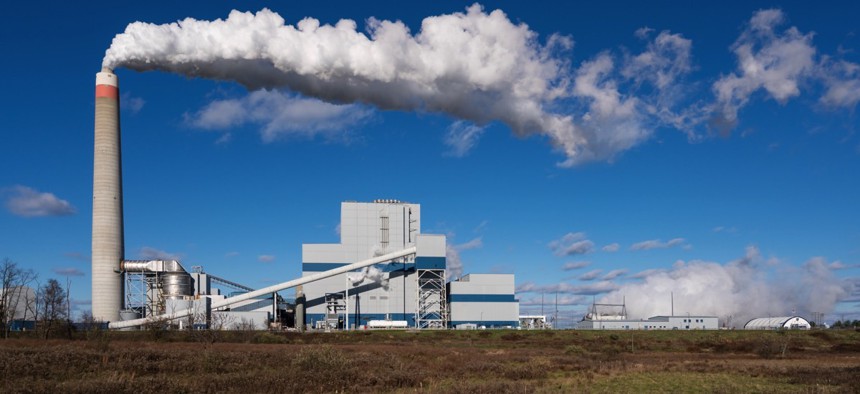Cities’ Progress Toward Carbon Neutrality Gets Tougher

Shutterstock
Some, like Minneapolis, still rely heavily on polluting natural gas to heat buildings through frigid winters.
WASHINGTON — A network of 25 cities is accelerating toward their individual carbon reduction goals, but remaining emissions are proving the hardest to curb.
City sustainability and energy managers participating in a training on Wednesday at the World Resources Institute in D.C. were optimistic about their early strides in reducing emissions. But they said challenges remain in decarbonizing buildings and establishing cleaner electric grids.
The cities are pushing the move toward renewables as members of Bloomberg Philanthropies’ American Cities Climate Challenge. As part of that, WRI, Bloomberg Philanthropies and the Rocky Mountain Institute created the Renewables Accelerator to procure 2.8 gigawatts of renewable energy across its cities within two years.
Getting to their goals won’t be easy. A polar vortex earlier this winter saw temperatures in Minneapolis drop to -31 degrees, highlighting a barrier to the member city’s goals of reaching 100 percent renewable electric energy for municipal buildings by 2023 and citywide by 2030.
Natural gas is needed to heat Minneapolis’ buildings, accounting for 35 percent of the city’s carbon emissions. Simply converting all buildings to renewable electric would double costs, and a cheaper alternative energy source doesn’t exist, said Kim Harvey, director of sustainability for Minneapolis.
“There is not a specific pathway forward that’s been laid out, but I’m really encouraged by a number of interesting things that are coming out,” said Harvey. “One of them is the REALIZE Program, which is adopting a European model to do deep-energy retrofits to reduce energy use by more than 80 percent.”
Minneapolis is currently powered by 60 percent renewable energy, Harvey said, and on pace to meet its 2023 goal by performing energy efficiency improvements ahead of any conversion to renewable electric. The final 40 percent will require commitments from natural gas companies and suppliers, in addition to changing the way homes are insulated, he added.
Boston, another member city, is in the process of updating its Carbon Action Plan for the third time. The city plans to be carbon neutral by 2050.
“We need to move to a clean grid in order to make this work,” said Dave Musselman, municipal energy unit director for Boston. “And we also need to deeply decarbonize our buildings.”
Most cities have no history of directly procuring renewable energy because of the complexities, said Rushad Nanavatty, principal at RMI.
North Carolina and Florida are regulated monopoly states. Cities like Charlotte, North Carolina or Orlando, Florida must work closely with sole provider Duke Energy in setting their renewable portfolio standards.
The utility’s appetite doesn’t always match Orlando’s more “aggressive goals” like floating solar, said Ian LaHiff, energy project manager for the city.
Boston is in a customer choice area. “In theory the utility is neutral on where your [energy] supply is coming from,” Musselman said, but in actuality switching to renewables changes the market.
“I think it would be helpful if there was a renewable portfolio standard that is either countrywide or state specific, or even just mandate that states that don’t have those standards come up with them,” LaHiff said.
Harvey, with Minneapolis, said he wants to see the federal government establish a low-cost revolving loan fund to capture the savings from energy-efficient homes to fund more because it’s “difficult to justify the upfront capital expenditure.” Minneapolis is working to establish a fund with the goal of only developing low-energy homes by 2030.
The federal government should also preserve current fuel economy standards the Trump administration is attempting to roll back, Harvey added, because transportation is the largest carbon producer in rural states like Minnesota—requiring more vehicle miles traveled.
Wind and solar have become the lowest cost energy resources in most places with purchasing agreements “routinely undercutting just the operating costs of coal,” to the point where it’s cheaper to shut down existing plants and build ones for renewables than maintain the status quo, Nanavatty said.
That’s increasingly true of natural gas as well, he added, with Jim Robo—CEO of the second-largest energy utility in the U.S., NextEra Energy—saying he won’t build another gas peaker plant past 2020.
“The economics have fundamentally changed,” Nanavatty said. “And not everyone has caught up to that reality; these guys have.”
Dave Nyczepir is a News Editor at Route Fifty and is based in Washington, D.C.
NEXT STORY: When Schools Tell Kids They Can’t Use the Bathroom






